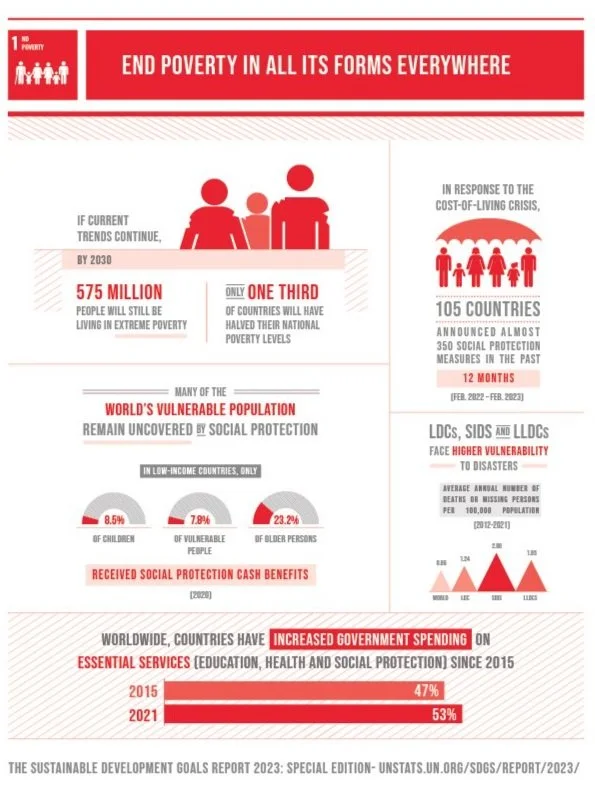No Poverty SDG
Poverty is a complex global challenge, touching every aspect of human life and impeding sustainable development. Sustainable Development Goal 1 (SDG 1), part of the United Nations’ 2030 Agenda, seeks to “End poverty in all its forms everywhere.” To achieve this, SDG 1 emphasizes multidimensional approaches, addressing income poverty, access to basic services, resilience, and resource mobilization.
NAV, a non-profit organization committed to transforming the lives of at-risk youth in foreign countries, exemplifies how community-driven initiatives can contribute to achieving SDG 1. By focusing on Nurture, Aid, and Vision, NAV provides holistic support that addresses poverty’s root causes while fostering long-term development. This paper explores NAV’s alignment with SDG 1 targets and its impactful approach to poverty alleviation in foreign nations.
Understanding SDG 1 and Its Relevance to NAV’s Mission
SDG 1 is composed of seven targets and fourteen indicators. These include eradicating extreme poverty (Target 1.1), reducing poverty in all its dimensions (Target 1.2), implementing social protection systems (Target 1.3), ensuring access to economic resources and basic services (Target 1.4), and building resilience (Target 1.5). The remaining targets focus on resource mobilization (Target 1.a) and fostering pro-poor and gender-sensitive policies (Target 1.b).
NAV’s mission—to empower and uplift at-risk youth—aligns seamlessly with these goals. By promoting long-term educational opportunities for children, NAV contributes to reducing vulnerabilities and fostering sustainable development in the communities it serves.
How NAV Tackles SDG 1 Targets
1. Nurture: Laying a Foundation for Growth
One of NAV’s core pillars is Nurture, which focuses on creating supportive environments that fulfill emotional and physical needs. This approach directly supports Target 1.2, which seeks to reduce multidimensional poverty by addressing non-income-based aspects of deprivation.
Cutting out cost: NAV works to cut out-of-pocket cost of sending a child to school by providing school supplies. This frees scarce household income for food, health care, and shelter that would otherwise be used for school supplies.
Emotional and Physical Well-being: By fostering educational environments for children, NAV attempts to alleviate the negative emotional impacts that can occur in impoverished communities, empowering youth to prioritize growth and development.
2. Aid: Addressing Immediate and Individual Needs
Aid, NAV’s second pillar, emphasizes resource provision tailored to the unique circumstances of youth and their families. This pillar aligns with multiple SDG 1 targets, particularly 1.4.
Access to Resources (Target 1.4): Education is a basic service, by removing a key barrier to entry by providing school supplies, we expand access for children in need with low income.
3. Vision: Investing in the Future
Vision focuses on long-term strategies to ensure youth can achieve sustainable livelihoods, directly aligning with Targets 1.4 and 1.5.
Educational Opportunities: By providing school supplies, NAV helps children gain access to quality education, breaking the intergenerational cycle of poverty and contributing to sustained economic growth.
Job Creation and Skill Development: NAV’s programs aim to equip youth with skills and resources to secure employment through education, thereby fostering resilience and reducing their vulnerability to poverty.
Healthcare and Resilience (Target 1.5): NAV supports resilience of the poor by providing children with education, leading them to raise their lifetime earnings and increase their income.
NAV’s Role in Mobilizing Resources (Target 1.a)
SDG 1 emphasizes the importance of resource mobilization to eradicate poverty. NAV’s fundraising initiatives and partnerships with international donors demonstrate how non-profits can contribute to this target. By leveraging private and public sector support, NAV mobilizes material resources, ensuring that its programs reach the most vulnerable populations.
Pro-Poor and Gender-Sensitive Policies (Target 1.b)
NAV’s commitment to inclusivity ensures that its programs address the unique challenges faced by different demographic groups. For example:
Gender-Sensitive Approaches: NAV prioritizes the needs of young girls, who often face additional barriers to education.
Community Engagement: By working with local stakeholders, NAV fosters community-driven solutions that reflect the realities of those it serves.
Measurable Impact: Indicators of Success
To monitor its impact, NAV could align its reporting with SDG 1 indicators:
Reduction in Poverty Levels: Tracking the number of youth lifted out of multidimensional poverty through its programs.
Access to Education and Healthcare: Measuring improvements in enrollment rates, healthcare access, and nutritional status.
Economic Resilience: Monitoring the percentage of program beneficiaries who secure employment or start small businesses.
Community Development: Evaluating the long-term socio-economic benefits of NAV’s initiatives in partner communities.
Challenges and Opportunities
Challenges
Resource Constraints: Limited funding can hinder NAV’s ability to scale its operations.
Geopolitical Instability: Operating in foreign countries often involves navigating complex political and social landscapes.
Opportunities
Partnerships: Collaborating with governments, international organizations, and private sector actors can amplify NAV’s impact.
Conclusion
NAV exemplifies how a focused, grassroots approach can contribute meaningfully to global efforts to eradicate poverty. By addressing the multidimensional aspects of poverty through its Nurture, Aid, and Vision pillars, NAV not only aligns with SDG 1 targets but also empowers at-risk youth to lead fulfilling lives. With continued resource mobilization, strategic partnerships, and a commitment to inclusivity, NAV has the potential to create lasting change in the communities it serves—and to inspire similar efforts worldwide.
Through its mission, NAV underscores the importance of investing in the next generation as a pathway to sustainable development. Ending poverty is not just a goal; it is a moral imperative that NAV actively pursues, one child at a time.
